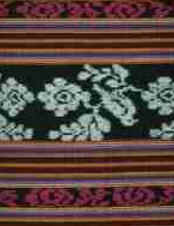RELIGION AND TRADITION
Christianity was the chosen religion in West Timor and Catholicism in East Timor, and despite the relative poverty in rural Timor, Sunday mornings are a bright and lively affair when people make their way to and from the churches on foot or truck dressed in their finest. I am usually the most crumpled grotty one on the bus.
However, most of rural Timor still also practices Animism, the worship of nature, to some degree. To this end Timorese statues and masks still have their role to play.
 |  |
 |  |
Dancing, singing, costume and musical ceremony (using gongs and drums) are all used to celebrate or ask for help from the deities. Some of the occasions that call for these ceremonies are: for planting and to ask for prosperity and good weatherfor the spinning of cotton for the smooth running of village or regional affairs; for weddings and other celebrations; and the offering of friendship and reaffirmation of allegiance through royalties or tribute along with the ever present betel nut.
 |  |
 |  |
Strong ties and allegiances still weave their way through Timorese society. Although the government puts its people into administering and heading up the enclaves there is always a "popular ruler" and many of the traditional village roles are still active. For instance, the medicine men and who are engaged to see who may have taken your cow, crops or cash, or who cast a ‘sickness» over you; and who then advise what to do.
For an in-depth analysis of a section of rural Timorese social structures and culture please refer to "Paths of Origin, Gates of Life: a study of place and precedence in West Timor" by Andrew McWilliam. ISBN 9067181986. McWilliam's bibliography includes other texts rich in information about Timorese customs and traditions.
Adverse changes in Timor
Some recent events have affected rural life in Timor. In 1998 the Indonesian rupiah fell to one third of its previous value, the price of rice trebled and wages didn't. This deeply affected the poorer Timorese and is evidenced by the threadbare clothing seen in the kampongs. Food comes first.
The independence of East Timor in 1999 has put further pressures on West Timor, with a large influx of pro-Indonesian and displaced people requiring a place and plot of land. This is followed by the need for extra water and wood for day-to-day living. Mostly the integration has been harmonious, but in some places closer to Kupang there has been violence and retribution.
 | |
 |  |
A cooperative way of life
A cooperative way of life in the villages sees family groups working their gardens that are often two to five kilometres from the house.
You will also see groups of men singing and chanting as they make their way through the village carrying the handmade roof trusses and framework for walls of new houses. These and the re-thatching of roofs require that the receiving person or family must cater for the workers by providing a pig and food, drinks, cigarettes and ample betel nut to see the project through in good spirit. This can be a heavy financial burden, but a socially beneficial event.
Households that may have a waged job are opting for galvanised roofs instead. These are hotter in summer, colder in winter and deafening in the rain - but they take just one day to erect and may not need replacing for up to ten years, compared to the grass thatch which needs repair from five years on and replacement every 20 years or so.
 |  |
Timorese dwellings
Most Timorese have two or three dwellings on their land.
The first seen is the Lopo. This half beehive shaped grass thatch dome is supported by four large tree trunks or pillars that are capped by large disks of stone or wood to make the false roof rat proof. The floor is raised stone packed with mud. There are usually two platforms at thigh height between opposite pillars. These act as a resting place when it is hot; a place to weave and carve;or to sit and chat and chew. This is also a space to gather and dry the important corn crop, which will then be stored with the weavings and statues. It is eaten throughout the year as "pen bose" - corn stew - and then planted out in the next rainy season
 |  |
 |  |
The main dwelling is a four-roomed square house. At the front will be the "guest" or "greeting" room, usually containing plastic chairs and a small table for the serving of refreshments. Then a bedroom off that which usually contains a wood slat bed and grass mat, or if affordable, a kapok mattress (innerspring beds are for the well off), and a small cupboard to hold personal effects. The back half of the house will usually have another bedroom, and there is a sort of dining tea and coffee preparation area.
The walls are often made of half handmade concrete blocks or rocks and the top half palm stems. The floors are all of compacted mud.
 |  |
The kitchen
The cooking, however, is done out the back in the "ume kububu", the third dwelling. This is a large beehive with thatch to the ground, very thick and providing excellent insulation. The inside of the thatch is blackened with the smoke of cooking fires. There is rarely adequate, if any, ventilation, other than the small entry door. These are used in the "wet" season when all around the house turns to slush and the surrounding grounds are worked as gardens (the wealth of the gardens in the "wet" dictate the wealth of the family in the "dry" season.)
The ume kububu has knee high bamboo slat bed frames around the back wall and often a homemade shelf for cooking utensils. From the cross beams hangs an assortment of household items, palm umbrellas, rice winnowing trays, hurricane lanterns, and skeins of cotton often hanging off a boar's jaw. Cooking is done on some strategically placed rocks and fed by wood in the centre of the room. Corn pounders stand alongside the handmade clay water pots. In a good season the inside may be lined with extra corn unable to be stored in the lopo, or for extra security.
 |  |
 |  |
 |  |
 | |
The betel nut ritual
Pua or betel nut still plays a very important role in Timorese society. Most men and some women enjoy a chew, some from early morning through to dark. It puts more oxygen into the blood and staves off hunger, allowing the people to work longer and harder. Much like the coca leaf for the South American Indians.
Much ritual surrounds the chewing of betel, and you can get a long way in Timorese society with your pockets full of betel nut.
Where possible the fresh nut is preferred, though dried betel is available all year. There is an asparagus type fruit thrown in the mix, and when this is not available the leaf of its vine will suffice. Add to this just the right amount of lime powder, and chew and chew, without swallowing. Your mouth, lips and teeth turn red and you dribble, and eventually spit out the excess. Chewing tobacco is an optional extra.
Tempat Kapur or Lime containers are still made and used daily by the people of Timor. There is a distinctive style to house the nut, leaf and tobacco and another in which the lime powder resides invariably intricately carved with the traditional motifs of Timor. They are mostly made from bamboo although may be found in finely carved wood, gourds, bone, buffalo horn and coconut. Sitting beneath the tree in the heat of the day is a good time for a chew and to work on your latest container. It is a humble artform in which you will find Timorese art at its most unaffected.














